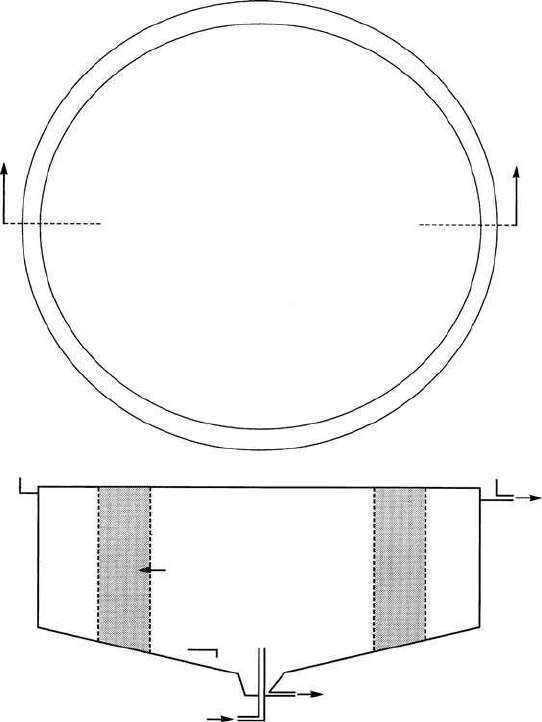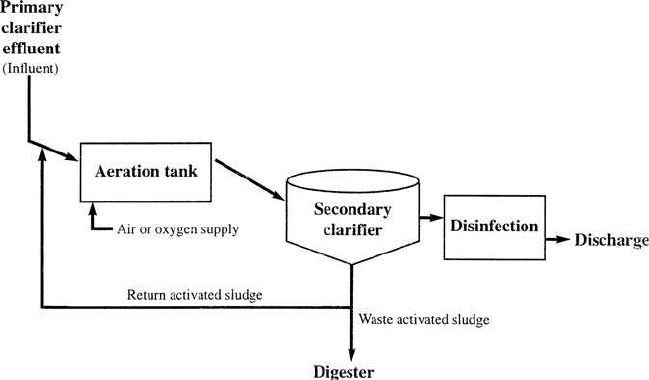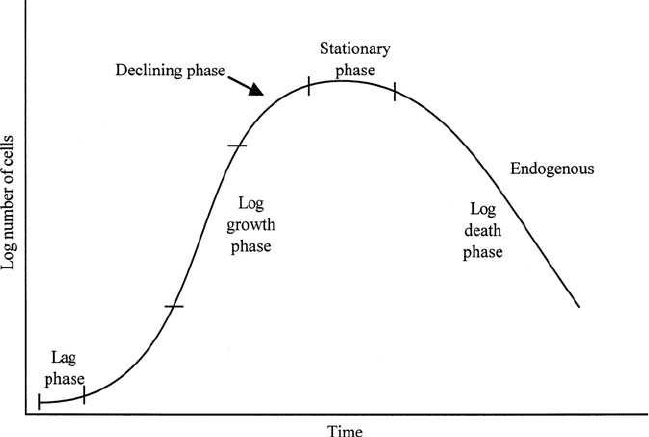Lin S.D. Water and Wastewater Calculations Manual
Подождите немного. Документ загружается.


Peripheral weirs shall be placed at least 300 cm (1 ft) from the well (Ten
States Standards, GLUMRB, 1996).
Example 1: Design circular clarifiers using English system units with the
same given information as in the example for rectangular clarifiers design.
solution:
Step 1. Calculate surface area A
Wastewater Engineering 615
Inlet zone
Settling zone
Outlet
zone
12
1
Figure 6.12 Typical circular basin design-plan view and cross section.

Design 2 circular clarifiers, each treating 1.0 Mgal/d with an overflow rate
of 700 gal/(d ⭈ ft
2
).
A ⫽ 1,000,000 (gal/d)/700 gal/(d ⭈ ft
2
)
⫽ 1429 ft
2
⫽ 132.8 m
2
Step 2. Determine the tank radius r
pr
2
⫽ 1429
r
2
⫽ 1429/3.14 ⫽ 455
r ⫽ 21.3 ft
Use d ⫽ 44 ft (13.4 m) diameter tank
Surface area ⫽ 1520 ft
2
(141 m
2
)
Step 3. Check overflow rate
Overflow rate ⫽ 1,000,000 (gal/d)/1520 ft
2
⫽ 658 gal/(d ⭈ ft
2
)
⫽ 26.8 m
3
/(m
2
⭈ d)
From Fig. 6.11, BOD
5
removal for an overflow rate of 658 gal/(d ⭈ ft
2
)
is 35%.
Step 4. Determine detention time t
Use a wastewater side wall depth of 10 ft and, commonly, plus 2-ft freeboard
for wind protection
Step 5. Calculate weir loading rate
Use an inboard weir with diameter of 40 ft (12.2 m)
Length of periphery ⫽ p ⫻ 40 ft ⫽ 125.6 ft
Weir loading ⫽ 1,000,000 (gal/d)/125.6 ft
⫽ 7960 gal/(d ⭈ ft)⫽98.8 m
3
/m ⭈ d
Step 6. Calculate the number (n) of V notches
5 2.73 h
5 0.114 day
t 5
1520 ft
2
3 10 ft 3 7.48 gal/ft
3
1,000,000 gal
616 Chapter 6
Use 90⬚ standard V notches at rate of 8 in center-to-center of the launders.
n ⫽ 125.6 ft ⫻ 12 in/ft ⫼ 8 in
⫽ 188
Step 7. Calculate average discharge per notch at average design flow q
q ⫽ 1,000,000 gal/d ⫻ (1 d/1440 min) ⫼ 188
⫽ 3.7 gal/min ⫽ 14 L/min
Example 2: If the surface overflow rate is 40 m
3
/(m
2
⭈ d) [982 gal/(d ⭈ ft
2
)] and
the weir overflow rate is 360 m
3
/(d ⭈ m) [29,000 gal/(d ⭈ ft)], determine the max-
imum radius for a circular primary clarifier with a single peripheral weir.
solution
Step 1. Compute the area (A) required with a flow (Q)
Let r ⫽ the radius of the clarifier
A ⫽ pr
2
⫽ Q/40 m
3
/(m
2
⭈ d) or Q ⫽ 40 pr
2
Step 2. Compute the weir length (⫽ 2pr)
2pr ⫽ Q/360 m
3
/(d ⭈ m)
or
Q ⫽ 720pr m
3
/(d ⭈ m)
Step 3. Compute r by solving the equations in Steps 1 and 2
pr
2
⫽ 720pr [m
3
/(d ⭈ m)]/40 [m
3
/(m
2
⭈ d)]
r ⫽ 18 m (59 ft)
20 Biological (Secondary) Treatment
Systems
The purpose of primary treatment is to remove suspended solids and
floating material. In many situations in some countries, primary treat-
ment with the resulting removal of approximately 40% to 60% of the sus-
pended solids and 25% to 35% of BOD
5
, together with removal of
material from the wastewater, is adequate to meet the requirement of
the receiving water body. If primary treatment is not sufficient to meet
the regulatory effluent standards, secondary treatment using a biolog-
ical process is mostly used for further treatment due to its greater
removal efficiency and less cost than chemical coagulation. Secondary
treatment processes are intended to remove the soluble and colloidal
organics (BOD) which remain after primary treatment and to achieve
further removal of suspended solids and, in some cases, also to remove
Wastewater Engineering 617

nutrients such as phosphorus and nitrogen. Biological treatment
processes provide similar biological activities to waste assimilation,
which would take place in the receiving waters, but in a reasonably
shorter time. Secondary treatment may remove more than 85% of BOD
5
and suspended matter, but is really not effective for removing nutrients,
nonbiodegradable organics, heavy metals, and microorganisms.
Biological treatment systems are designed to maintain a large active
mass and a variety of microorganisms, principally bacteria (and fungi,
protozoa, rotifers, algae, etc.), within the confined system under favor-
able environmental conditions, such as dissolved oxygen, nutrient, etc.
Biological treatment processes are generally classified mainly as sus-
pended growth processes (activated sludge, Fig. 6.13), attached (film)
growth processes (trickling filter and rotating biological contactor,
RBC), and dual-process systems (combined). Other biological waste-
water treatment processes include the stabilization pond, aerated
lagoon, contaminant pond, oxidation ditch, high-purity oxygen acti-
vated sludge, biological nitrification, denitrification, and phosphorus
removal units.
In the suspended biological treatment process, under continuous
supply of air or oxygen, living aerobic microorganisms are mixed thor-
oughly with the organics in the wastewater and use the organics as
food for their growth. As they grow, they clump or flocculate to form an
active mass of microbes. This is so-called biologic floc or activated sludge.
618 Chapter 6
Figure 6.13 Conventional activated sludge process.

20.1 Cell growth
Each unicellular bacterium grows and, after reaching a certain size,
divides to produce two complete individuals by binary fission. The period
of time required for a growing population to double is called the gener-
ation time. With each generation, the total number increases as the
power (exponent) of 2, i.e. 2
0
, 2
1
, 2
2
, 2
3
. . . The exponent of 2 correspon-
ding to any given number is the logarithm of that number to the base
2 (log
2
). Therefore, in an exponentially growing culture, the log
2
of the
number of cells increasing in proportion to time, is often referred to as
logarithmic growth.
The growth rate of microorganisms is affected by environmental con-
ditions, such as DO levels, temperature, nutrient levels, pH, micro-bial
community, etc. Exponential growth does not normally continue for a
long period of time. A general growth pattern for fission-reproduction
bacteria in a batch culture is sketched in Fig. 6.14. They are the lag
phase, the exponential (logarithmic) growth phase, the maximum
(stationary) phase, and the death phase.
When a small number of bacteria is inoculated into a fixed volume of
vessel with culture medium, bacteria generally require time to accli-
matize to their environmental condition. For this period of time, called
the lag phase, the bacterial density is almost unchanged. Under excess
Wastewater Engineering 619
Figure 6.14 Bacterial density with growth time.

food supply, a rapid increase in number and mass of bacteria occurs in
the log growth phase. During this maximum rate of growth a maxi-
mum rate of substrate removal occurs. Either some nutrients become
exhausted, or toxic metabolic products may accumulate. Subsequently,
the growth rate decreases and then ceases. For this period, the cell
number remains stationary at the stationary phase. As bacterial den-
sity increases and food runs short, cell growth will decline. The total
mass of protoplasm exceeds the mass of viable cells, because bacteria
form resistant structures such as endospores.
In the endogenous growth period, the microorganisms compete for
the limiting substrate even to metabolize their own protoplasm. The
rate of metabolism decreases and starvation occurs. The rate of death
exceeds the rate of reproduction; cells also become old, die exponen-
tially, and lysis. Lysis can occur in which the nutrients from the dead
cells diffuse out to furnish the remaining living cells as food. The
results of cell lysis decrease both the population and the mass of
microorganisms.
In the activated-sludge process, the balance of food to microorganisms
is very important. Metabolism of the organic matter results in an
increased mass of microorganisms in the process. The excess mass of
microorganisms must be removed (waste sludge) from the system to
maintain a proper balance between mass of microorganisms and sub-
strate concentration in the aeration basin.
In both batch and continuous culture systems the growth rate of bac-
terial cells can be expressed as
r
g
⫽ mX (6.57)
where r
g
⫽ growth rate of bacteria, mg/(L ⭈ d)
m ⫽ specific growth rate, per day
X ⫽ mass of microorganism, mg/L
since
(6.58)
Therefore
(6.59)
Substrate limited growth. Under substrate limited growth conditions,
or for an equilibrium system, the quantity of solids produced is equal
dX
dt
5 mX
dX
dt
5 r
g
620 Chapter 6

to that lost, and specific growth rate (the quantity produced per day) can
be expressed as the well-known Monod equation
(6.60)
where m ⫽ specific growth rate, per day
m
m
⫽ maximum specific growth rate, per day
S ⫽ concentration for substrate in solution, mg/L
K
s
⫽ half velocity constant, substrate concentration at
one-half the maximum growth rate, mg/L
k
d
⫽ cell decay coefficient reflecting the endogenous burn-up
of cell mass, mg/(mg ⭈ d)
Substituting the value of from Eq. (6.60) into Eq. (6.57), the resulting
equation for the cell growth rate is
(6.61)
21 Activated-Sludge Process
The activated-sludge process was first used in Manchester, England.
This process is perhaps the most widely used process for secondary
treatment of wastewaters. Recently, the activated-sludge process has
been applied as a nitrification and denitrification process, and modified
with an anoxic and anaerobic section for phosphorus removal.
A basic suspended-growth (activated-sludge) process is depicted in
Fig. 6.13. The wastewater continuously enters an aeration tank where
previously developed biological flocs are brought into contact with the
organic material of the wastewater. Air or oxygen-enriched air is con-
tinuously injected into the aeration tank as an oxygen source to keep the
system aerobic and the activated sludge in suspension. Approximately
8 m
3
of air is required for each m
3
of wastewater.
The microbes in the activated sludge consist of a gelatinous matrix of
filamentous and unicellular bacteria which are fed on protozoa. The
predominant bacteria, such as Pseudomonas, utilize carbohydrate and
hydrocarbon wastes, whereas Bacillus, Flavobacterium, and Alcaligenes
consume protein wastes. When a new activated-sludge system is first
started, it should be seeded with activated sludge from an existing oper-
ating plant. If seed sludge is not available, activated sludge can be pre-
pared by simply continuously aerating, settling, and returning settled
solids to the wastewater for a few weeks (4 to 6 weeks) (Alessi et al, 1978;
Cheremisinoff, 1995).
r
g
5
m
m
SX
K
s
1 S
2 k
d
m 5 m
m
S
K
s
1 S
2 k
d
Wastewater Engineering 621
The microorganisms utilize the absorbed organic matter as a carbon
and energy source for cell growth and convert it to cell tissue, water, and
oxidized products (mainly carbon dioxide, CO
2
). Some bacteria attack
the original complex substance to produce simple compounds as their
waste products. Other bacteria then use these waste products to produce
simpler compounds until the food is used up.
The mixture of wastewater and activated sludge in the aeration basis
is called mixed liquor. The biological mass (biomass) in the mixed liquor
is called the mixed liquor suspended solids (MLSS) or mixed liquor
volatile suspended solids (MLVSS). The MLSS consists mostly of
microorganisms, nonbiodegradable suspended organic matter, and other
inert suspended matter. The microorganisms in MLSS are composed of
70% to 90% organic and 10% to 30% inorganic matter (Okun, 1949;
WEF and ASCE, 1996a). The types of bacterial cell vary, depending on
the chemical characteristics of the influent waste-water tank conditions
and the specific characteristics of the microorganisms in the flocs.
Microbial growth in the mixed liquor is maintained in the declining or
endogenous growth phase to insure good settling properties.
After a certain reaction time (4 to 8 h), the mixed liquor is discharged
from the aeration tank to a secondary sedimentation basin (settling
tank, clarifier) where the suspended solids are settled out from the
treated wastewater by gravity. However, in a sequencing batch reactor
(SBR), mixing and aeration in the aeration tank are stopped for a time
interval to allow MLSS to settle and to decant the treated wastewater;
thus a secondary clarifier is not needed in an SBR system. Most con-
centrated biological settled sludge is recycled back to the aeration tank
(so-called return activated sludge, RAS) to maintain a high population
of microorganisms to achieve rapid breakdown of the organics in the
wastewater. The volume of RAS is typically 20% to 30% of the wastewater
flow. Usually more activated sludge is produced than return sludge.
The treated wastewater is commonly chlorinated and dechlorinated,
then discharged to receiving water or to a tertiary treatment system
(Fig. 6.3). The preliminary, primary, and activated-sludge (biological)
processes are included in the so-called secondary treatment process.
21.1 Aeration periods and BOD loadings
The empirical design of activated sludge is based on BOD loading, food-
to-microorganism ratio (F/M), sludge age, and aeration period. Empirical
design concepts are still acceptable. The Ten States Standards states
that when activated-sludge process design calculations are not submit-
ted, the aeration tank capacities and permissible loadings for the sev-
eral adoptions of the processes shown in Table 6.11 are used as simple
design criteria. Those values apply to plants receiving diurnal load
622 Chapter 6

ratios of design peak hourly BOD
5
to design BOD
5
ranging from 2:1 to
4:1 (GLUMRB, 1996).
The aeration period is the retention time of the influent wastewater
flow in the aeration basin and is expressed in hours. It is computed from
the basin volume divided by the average daily flow excluding the return
sludge flow. For normal domestic sewage, the aeration period commonly
ranges from 4 to 8 h with an air supply of 0.5 to 2.0 ft
3
/gal (3.7 to 15.0 m
3
/m
3
)
of wastewater. The return-activated sludge is expressed as a percentage
of the wastewater influent of the aeration tank.
The organic (BOD
5
) loading on an aeration basin can be computed
using the BOD in the influent wastewater without including the
return sludge flow. BOD loadings are expressed in terms of lb BOD
applied per day per 1000 ft
3
or [kg/(d ⭈ m
3
)] of liquid volume in the
aeration basin and in terms of lb BOD applied per day per lb of mixed
liquid volatile suspended solids. The latter is called the food-to-
microorganism ratio.
BOD loadings per unit volume of aeration basin vary widely from 10
to more than 100 lb/1000 ft
3
(0.16 to 1.6 kg/(d ⭈ m
3
)), while the aeration
periods correspondingly vary from 2.5 to 24 h (Clark et al., 1977). The
relationship between the two parameters is directly related to the BOD
concentration in the wastewater.
21.2 F/M ratio
The F/M ratio is used to express BOD loadings with regard to the micro-
bial mass in the process. The value of the F/M ratio can be calculated
Wastewater Engineering 623
TABLE 6.11 Permissible Aeration Tank Capacities and Loadings
Organic (BOD
5
) F/M ratio, lb
loading lb/(d ⭈ 1000 ft
3
) BOD
5
/d per lb
Process (kg/d ⭈ m
3
)
∗
MLVSS MLSS, mg/L
‡
Conventional step aeration 40(0.64) 0.2–0.5 1000–3000
complete mix
Contact stabilization
†
50
†
(0.80) 0.2–0.6 1000–3000
Extended aeration single-stage 15(0.24) 0.05–0.1 3000–5000
nitrification
Note: Loadings are based on the influent organic load to the aeration tank at plant design
average BOD
5
.
†
Total aeration capacity includes both contact and reaeration capacities; normally the
contact zone equals 30% to 35% of the total aeration capacity.
‡
The values of MLSS are dependent on the surface area provided for secondary settling
and the rate of sludge return as well as the aeration processes.
SOURCE: GLUMRB (Ten States Standards) (1996)

by the following equation:
(6.62)
(6.63)
or
(6.64)
where F/M ⫽ food-to-microorganism ratio, kg (lb) of BOD per day
per kg (lb) of MLSS
Q ⫽ wastewater flow, m
3
/d or Mgal/d
BOD ⫽ wastewater 5-day BOD, mg/L
V ⫽ liquid volume of aeration tank, m
3
or Mgal
MLSS ⫽ mixed liquor suspended solids in the aeration
tank, mg/L
In Eqs. (6.62) and (6.63), some authors use mixed liquor volatile sus-
pended solids instead of MLSS. The MLVSS is the volatile portion of the
MLSS and ranges from 0.75 to 0.85. Typically they are related, for
design purposes, by MLVSS ⫽ 0.80 ⫻ MLSS. The use of MLVSS may
more closely approximate the total active biological mass in the process.
The F/M ratio is also called the sludge loading ratio (SLR). The equa-
tion for the calculation of the SLR is (Cheremisinoff, 1995)
(6.65)
where SLR ⫽ sludge loading, g of BOD/d per g of MLVSS
BOD ⫽ wastewater BOD, mg/L
MLVSS ⫽ mixed liquor volatile suspended solids, mg/L
t ⫽ retention time, d
R ⫽ recyle ratio
Example 1: An activated-sludge process has a tank influent BOD con-
centration of 140 mg/L, influent flow of 5.0 Mgal/d (18,900 m
3
/d) and
35,500 lb (16,100 kg) of suspended solids under aeration. Calculate the
F/M ratio.
solution:
Step 1. Calculate BOD in lb/d
SLR 5
24 BOD
MLVSS stds1 1 Rd
F/M 5
BOD, kg/d
MLSS, kg
5
Q sMgal/dd 3 BOD smg/Ld 3 8.34 slb/gald
V sMgald 3 MLSS smg/Ld 3 8.34 slb/gald
F/M 5
BOD, lb/d
MLSS, lb
624 Chapter 6
